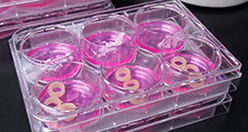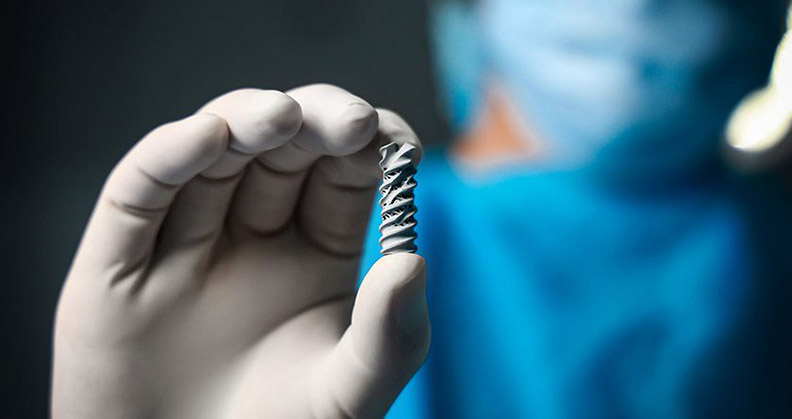
For robust sterilization processes, device companies are advised to take a deeper look at biocompatibility, endotoxins and their overall sterilization protocol. Recent updates to standards and regulatory guidance have made conducting these processes more complex.
These elements are among Martell Winters’ focus at Nelson Laboratories, a provider of global lab testing and consulting services. Mr. Winters serves as Director of Scientific Competency.
In a conversation about sterilization considerations for orthopaedic devices, Winters identified three aspects of the process that he feels are important for OEMs to understand.
Biocompatibility Testing
Biocompatibility testing, while common in industry, is far from simple.
Every device is required to be evaluated for three biological effects: cytotoxicity, sensitization and irritation. Each test screens for the presence of toxic, leachable materials. Based on the type of contact and duration of use of the device, several additional types of biological effects may be required. These considerations are driven by regulatory bodies and the ISO 10993 series of standards, as well as additional device-specific standards.
Deciding which biological effects are appropriate to evaluate is heavily based on risk, which allows for a unique conversation for every medical device. This experience can often present several questions and challenges to solve.
Winters discussed the need for OEMs’ greater understanding of biocompatibility. “It used to be you had a biocompatibility chart and you’d look up the type of product you had, you’d check the applicable boxes and you’re done,” Winters explained.
In recent years, though, that approach has changed significantly. Assessment of risk has been written into the 10993 series of standards for many years; however, it is only recently that the industry has pushed this further in an effort to reduce animal testing and to use existing data available for common materials used in medical devices. “You actually need to understand all of your materials and processing and justify your biocompatibility approach based on that information,” Winters said.
“We’re doing extractables (soluble substances removed from material when treated with solvent) and leachables (chemicals removed from a medical device by the action of water and other liquids related to the use of the device) testing on products. We see what types of compounds we can get off of the implant. Then, we assess those compounds, determine if any cause biocompatibility issues and supplement that info with in vitro and in vivo testing. There is now a greater understanding aspect to biocompatibility, rather than just checking boxes.”
Endotoxin Testing
In 2016, FDA revised its guidance titled “Submission and Review of Sterility Information in Premarket Notification 510(k) Submissions for Devices Labeled as Sterile.”
In this revision, Winters pointed out, a subtle change in verbiage surrounding the word “implant” ended up being a significant change regarding requirements for implanted products that are required to have endotoxin data.
In short, FDA expanded upon its discussion of pyrogen—a fever-inducing substance. In the 2008 draft guidance, the Agency said there should be a record of the testing done to show that certain devices—those that come in contact with blood or cerebrospinal fluid, are permanent implants or are labeled as non-pyrogenic or pyrogen free—are non-pyrogenic. The 2016 final guidance added a couple of new requirements for this testing documentation that extended to all implants (as opposed to just permanent implants), devices with indirect or direct contact with cerebrospinal fluid or the cardiovascular or lymphatic systems or “similar systemic exposure,” and those with non-pyrogenic labels.
This final guidance had a direct impact on orthopaedic implants, which are now more of a focus for FDA. For products that do circulate in the blood or in cerebrospinal fluid, the Agency expectation is that every batch of product is tested for endotoxins and the products have a non-pyrogenic label claim (products like tubing sets, or others manufactured in high volume). For orthopaedic implants, “a batch might be 5, or even 1,” Winters said. “We’ve worked with FDA substantially regarding a typical approach that would be good to use in those situations.”
Winters said that experience with FDA submissions indicates that it is comfortable with and amenable to the idea that, “instead of testing every single batch, which is not really feasible for many orthopaedic implants, a reasonable grouping of products can be tested with the addition of supplementary data on the process itself. That supplementary data often consists of a risk assessment of the process indicating where endotoxin might be present, along with mitigating activities, and also usually includes endotoxin testing of process water, when water is part of the process.”
This regulatory shift also spurred Nelson Labs to work with the Association for the Advancement of Medical Instrumentation (AAMI) to revise U.S. standards on endotoxin testing specific to medical devices, ANSI/AAMI ST72. This standard specifies general criteria to be applied in the determination of bacterial endotoxins (pyrogens) on sterilized or sterilizable healthcare products, components or raw materials. Endotoxin methodologies covered include both qualitative (limit) and quantitative (end-point) methods. ANSI/AAMI ST72 excludes determination of pyrogens other than bacterial endotoxins.
Sterility Assurance
Winters described another new initiative involving Nelson Labs and AAMI to produce documents addressing what they call “end-to-end sterility assurance.” The idea is that “sterility assurance is not something that is gifted merely by the sterilization process,” Winters explains. “It starts at the vendor approval stage, receiving, inspection, storage, manufacturing, cleaning, packaging….these all play a role in sterility assurance.”
The goal, according to Winters, is to work with AAMI to promote awareness on how sterility assurance should be thought of, rather than thinking of sterilization as an end-of-process step. “When you look at it as a process, rather than a step, you’re much more capable of avoiding problems rather than reacting to them when they happen,” he says.
Winters stressed that end-to-end sterility assurance means that sterilization experts need to have a place at the table, from device design throughout its life cycle.
No matter how innovative or ground-breaking an implant may be, it is useless if not able to be properly sterilized.
“There’s one thing we wish all [OEMs] would do: bring experts in earlier in the process,” Winters said. “We get customers who contact us quite regularly at the end of the process; we will see issues with things that they’ve already completed. If they had brought us in, or someone knowledgeable about sterilization, it could have been a much smoother process.”
*Image courtesy of Nelson Laboratories
Rob Meyer is ORTHOWORLD’s Senior Editor.




